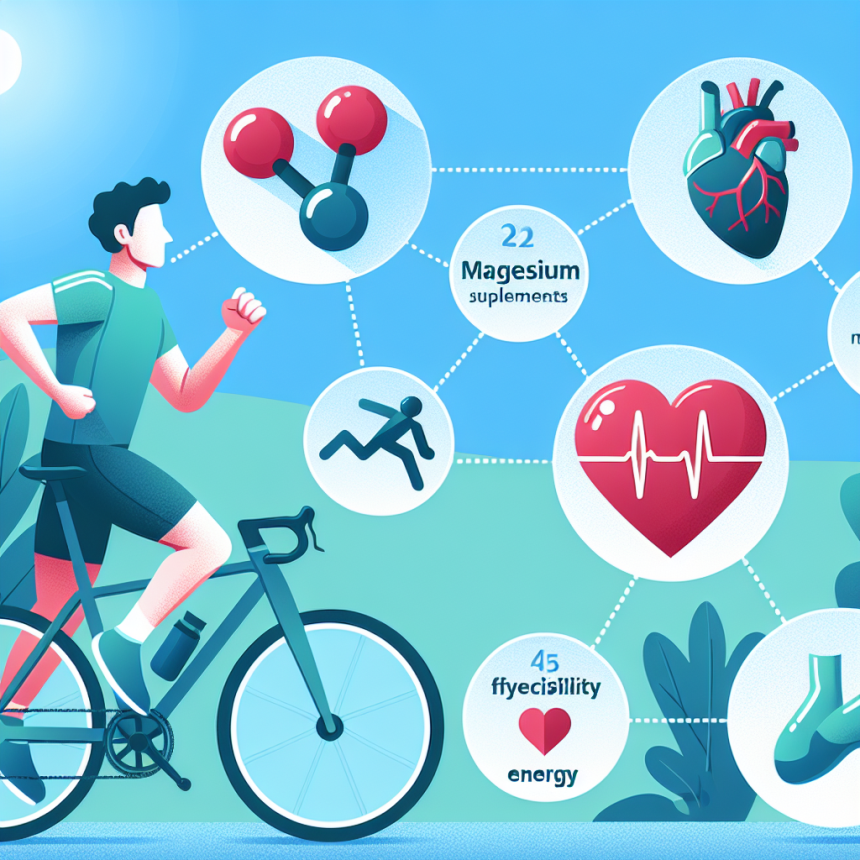-
Table of Contents
«Boost your cardio performance with Magnesium – the essential adaptation for a stronger, healthier workout.»
Introduction
When incorporating magnesium into your daily routine, it is important to consider any potential adaptations that may need to be made to your cardio workouts. Magnesium is a vital mineral that plays a crucial role in muscle function and energy production, making it an important factor to consider when engaging in physical activity. In this introduction, we will discuss some potential adaptations that may be necessary when taking magnesium and how it can impact your cardio routine.
The Benefits of Combining Magnesium with Cardio Workouts
Cardiovascular exercise, also known as cardio, is a crucial component of any fitness routine. It helps improve heart health, increase endurance, and burn calories. However, for some individuals, cardio workouts can be challenging and may lead to muscle cramps, fatigue, and other discomforts. This is where magnesium comes in. Magnesium is an essential mineral that plays a vital role in various bodily functions, including muscle and nerve function. Combining magnesium with cardio workouts can provide numerous benefits and help individuals achieve their fitness goals. In this article, we will explore the benefits of combining magnesium with cardio workouts and the adaptations that can be made to optimize its effects.
First and foremost, magnesium is essential for muscle function and energy production. During cardio workouts, our muscles require a significant amount of energy to sustain the activity. Magnesium helps in the production of adenosine triphosphate (ATP), which is the primary source of energy for our muscles. Without sufficient magnesium levels, our muscles may not be able to perform at their best, leading to fatigue and cramping. By taking magnesium before a cardio workout, individuals can ensure that their muscles have the necessary energy to sustain the activity, leading to improved performance and endurance.
Moreover, magnesium also plays a crucial role in preventing muscle cramps. During intense cardio workouts, our muscles contract and relax repeatedly, leading to the loss of electrolytes such as magnesium. When our magnesium levels are low, our muscles may experience involuntary contractions, also known as cramps. By taking magnesium before a cardio workout, individuals can replenish their magnesium levels and prevent muscle cramps, allowing them to push through their workouts without any discomfort.
In addition to its effects on muscle function, magnesium also has a significant impact on heart health. Cardio workouts put a strain on our cardiovascular system, and our heart needs to work harder to pump blood and oxygen to our muscles. Magnesium helps in regulating heart rhythm and maintaining healthy blood pressure levels. By taking magnesium before a cardio workout, individuals can support their heart health and reduce the risk of cardiovascular diseases.
Furthermore, magnesium can also aid in post-workout recovery. After a cardio workout, our muscles may feel sore and fatigued. This is because intense physical activity causes microscopic tears in our muscle fibers, which then repair and grow stronger during the recovery process. Magnesium plays a crucial role in this process by promoting protein synthesis and reducing inflammation. By taking magnesium after a cardio workout, individuals can speed up their recovery and reduce muscle soreness, allowing them to get back to their workouts sooner.
Now that we have explored the benefits of combining magnesium with cardio workouts, let’s discuss the adaptations that can be made to optimize its effects. Firstly, it is essential to ensure that you are taking the right type of magnesium. Magnesium supplements come in various forms, such as magnesium oxide, magnesium citrate, and magnesium glycinate. Magnesium glycinate is the most bioavailable form, meaning it is easily absorbed by the body. Therefore, it is recommended to take magnesium glycinate before a cardio workout for maximum benefits.
Secondly, it is crucial to consider the timing of magnesium intake. Ideally, magnesium should be taken 30-60 minutes before a cardio workout to allow for proper absorption and utilization by the body. Additionally, it is essential to stay hydrated during a cardio workout, as magnesium requires water to be absorbed and utilized effectively.
In conclusion, combining magnesium with cardio workouts can provide numerous benefits, including improved muscle function, prevention of cramps, support for heart health, and faster post-workout recovery. By making the necessary adaptations, individuals can optimize the effects of magnesium and achieve their fitness goals. So, the next time you plan on hitting the treadmill or going for a run, don’t forget to add magnesium to your pre-workout routine. Your body will thank you for it.
How to Modify Your Cardio Routine to Incorporate Magnesium
Cardiovascular exercise, also known as cardio, is an essential component of a healthy lifestyle. It helps improve heart health, increase endurance, and burn calories. However, for those who are taking magnesium supplements, it is important to make some adaptations to their cardio routine. Magnesium is a vital mineral that plays a crucial role in various bodily functions, including muscle and nerve function, energy production, and bone health. In this article, we will discuss how to modify your cardio routine to incorporate magnesium and reap its benefits.
First and foremost, it is essential to understand the importance of magnesium in our bodies. This mineral is responsible for over 300 biochemical reactions, making it crucial for overall health and well-being. It is also known as the «anti-stress» mineral as it helps relax muscles and calm the nervous system. When we engage in cardio exercise, our muscles require more magnesium to function properly. Therefore, it is essential to ensure that our magnesium levels are adequate to support our cardio routine.
One way to modify your cardio routine to incorporate magnesium is to time your supplement intake. It is recommended to take magnesium supplements at least 30 minutes before your cardio workout. This will allow the body to absorb the mineral and have it readily available for your muscles during exercise. It is also advisable to take magnesium with a meal or snack that contains healthy fats, as they aid in the absorption of this mineral.
Another adaptation to consider is the type of cardio exercise you engage in. High-intensity exercises, such as running or HIIT (High-Intensity Interval Training), can deplete magnesium levels in the body. Therefore, it is crucial to incorporate low-impact exercises, such as walking, cycling, or swimming, into your routine. These exercises are less strenuous on the body and do not require as much magnesium. Additionally, incorporating stretching and yoga into your routine can also help relax the muscles and reduce the risk of magnesium depletion.
Hydration is another crucial factor to consider when modifying your cardio routine to incorporate magnesium. Sweating during exercise can cause the body to lose essential minerals, including magnesium. Therefore, it is vital to stay hydrated and replenish lost electrolytes. You can do this by drinking plenty of water and incorporating electrolyte-rich drinks, such as coconut water or sports drinks, into your routine. These drinks contain magnesium and other minerals that can help maintain electrolyte balance in the body.
Furthermore, it is essential to listen to your body and adjust your cardio routine accordingly. If you experience muscle cramps, fatigue, or other symptoms of magnesium deficiency, it may be a sign that you need to modify your routine. It is crucial to consult with a healthcare professional to determine the appropriate dosage of magnesium supplements for your specific needs. They can also help you create a personalized cardio routine that takes into account your magnesium levels and overall health.
In conclusion, incorporating magnesium into your cardio routine is essential for maintaining overall health and optimizing your workout. By timing your supplement intake, choosing low-impact exercises, staying hydrated, and listening to your body, you can modify your cardio routine to incorporate magnesium effectively. Remember to consult with a healthcare professional before making any significant changes to your exercise routine, and always prioritize your safety and well-being. With these adaptations, you can reap the benefits of both cardio exercise and magnesium for a healthier and happier you.
Maximizing the Effects of Magnesium on Cardiovascular Health
Magnesium is an essential mineral that plays a crucial role in maintaining our overall health. It is involved in over 300 biochemical reactions in the body, including muscle and nerve function, energy production, and maintaining a healthy immune system. One of the most significant benefits of magnesium is its impact on cardiovascular health. Studies have shown that magnesium can help lower blood pressure, reduce the risk of heart disease, and improve overall heart function. However, to maximize the effects of magnesium on cardiovascular health, certain adaptations must be made to our cardio routine.
First and foremost, it is essential to understand the recommended daily intake of magnesium. The recommended daily intake for adults is between 310-420 mg, depending on age and gender. However, this amount may vary for individuals with certain health conditions or those taking certain medications. It is always best to consult with a healthcare professional to determine the appropriate dosage for your specific needs.
Once you have determined the appropriate dosage, it is crucial to incorporate magnesium-rich foods into your diet. Foods such as leafy greens, nuts, seeds, and whole grains are excellent sources of magnesium. By incorporating these foods into your diet, you can ensure that your body is getting the necessary amount of magnesium to support your cardiovascular health.
In addition to a healthy diet, it is also essential to make adaptations to your cardio routine when taking magnesium. One of the most significant adaptations is to increase the intensity of your workouts gradually. Magnesium plays a vital role in energy production, and by gradually increasing the intensity of your workouts, you can ensure that your body has enough magnesium to support your energy needs. Sudden and intense workouts can deplete magnesium levels, leading to fatigue and muscle cramps.
Another adaptation to consider is the timing of your magnesium intake. It is recommended to take magnesium supplements at least 30 minutes before a workout. This allows the body enough time to absorb the magnesium and utilize it during the workout. Taking magnesium after a workout may not have the same impact on cardiovascular health as taking it before.
Furthermore, it is essential to stay hydrated when taking magnesium. Magnesium works in conjunction with other electrolytes, such as potassium and sodium, to maintain proper fluid balance in the body. When engaging in cardio activities, it is crucial to replenish lost fluids to maintain proper electrolyte balance. Drinking water or electrolyte-rich beverages during and after a workout can help maintain proper hydration levels and maximize the effects of magnesium on cardiovascular health.
Additionally, it is essential to listen to your body when taking magnesium and engaging in cardio activities. If you experience any adverse effects, such as nausea, diarrhea, or muscle cramps, it is crucial to consult with a healthcare professional. They can help determine if the dosage needs to be adjusted or if there are any underlying health conditions that may be causing these side effects.
In conclusion, magnesium is a vital mineral for maintaining cardiovascular health. By incorporating magnesium-rich foods into your diet, gradually increasing the intensity of your workouts, taking magnesium before a workout, staying hydrated, and listening to your body, you can maximize the effects of magnesium on your cardiovascular health. However, it is always best to consult with a healthcare professional before making any significant changes to your diet or exercise routine. With the right adaptations, you can reap the full benefits of magnesium and support your overall cardiovascular health.
Q&A
1. ¿Cómo afecta el magnesio al ejercicio cardiovascular?
El magnesio es un mineral esencial para el correcto funcionamiento del sistema cardiovascular. Ayuda a regular la frecuencia cardíaca y la presión arterial, lo que puede mejorar el rendimiento durante el ejercicio cardiovascular.
2. ¿Es necesario hacer adaptaciones en el cardio al tomar suplementos de magnesio?
No necesariamente, ya que el magnesio se encuentra en muchos alimentos y una dieta equilibrada puede proporcionar la cantidad adecuada de este mineral. Sin embargo, si se toman suplementos de magnesio, es importante seguir las recomendaciones de dosis y consultar con un profesional de la salud antes de hacer cambios en la rutina de ejercicio.
3. ¿Qué adaptaciones se pueden hacer al cardio al tomar magnesio?
Al tomar magnesio, es importante mantener una hidratación adecuada durante el ejercicio cardiovascular, ya que este mineral puede tener un efecto diurético. También se recomienda seguir una dieta equilibrada y variada para asegurar una ingesta adecuada de otros nutrientes importantes para el rendimiento físico. Además, es importante escuchar al cuerpo y ajustar la intensidad del ejercicio si se experimentan efectos secundarios como calambres musculares o fatiga.





